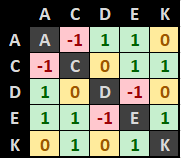Hello,
I'm looking for some mathematical method/algorithm.
I want to find the most members to form a groups.
I'll present my problem by example:
I got a set of vitamins: [A, C, D, E, K]
I got a correlation table betweeen them (synergy/antagonistic/null)

The algorithm has find best fitting groups.
* best fitting groups are these who have the most members (and the members of the groups don't duplicate / group has unique members)
Does anyone knows any algorithm or mathematical method to solve this problem?
I'm looking for some mathematical method/algorithm.
I want to find the most members to form a groups.
I'll present my problem by example:
I got a set of vitamins: [A, C, D, E, K]
I got a correlation table betweeen them (synergy/antagonistic/null)

The algorithm has find best fitting groups.
* best fitting groups are these who have the most members (and the members of the groups don't duplicate / group has unique members)
Does anyone knows any algorithm or mathematical method to solve this problem?
